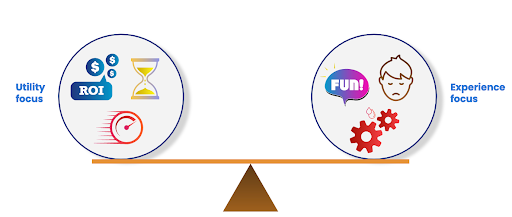On the face of it, B2B and B2C firms’ structures and processes appear completely divergent. When thinking about B2B, one visualizes large sales teams (in suits), dedicated account managers, conferences, customer meetings etc. In the B2C world, we think of scale, branding, mass marketing etc.

The case for confusion:
However, looking a little closer, we will realize that the characteristics that are used to define B2B products are found in some B2C products and vice versa.
Here are some examples –
- Gmail/Gsuite, Amazon, Makemytrip etc => The same product serves both individuals and businesses
- Superhuman looks like both a B2C and a B2B product when we look at it from different lenses
- PayTM merchant services has 30 million customers – not the typical small scale that we expect of a B2B product.
The lines between B2B & B2C are blurred and so are their product management practices.

Alternate approach
Given the blurry differences, we will discuss the underlying attributes that determine relevant product management practices instead of trying to directly compare & contrast B2B and B2C products.
The relevant attributes are –
- Number of stakeholders (on the customer side)
- Size of the user base
- Ticket size
- Customer decision-making style
- Distribution and GTM
At the extreme ends of the spectrum, these attributes denote pure B2B & pure B2C plays. But most products lie somewhere in the middle using some combination of these attributes.
1. Number of stakeholders on the customer side:
B2C products tend to have just one stakeholder on the customer side whereas, in B2B, the number of stakeholders is generally more than 1 (e.g. users, finance, HR, compliance, admin, senior management etc).
However, there are exceptions in B2C like edtech, travel etc where multiple members of a family or group of friends tend to be stakeholders.
Similarly, on the B2B side, small tools (e.g. PDF converter) with a low price have just one stakeholder – an employee using a discretionary purchase budget to buy tools.

Implications to product management:
When there are more stakeholders, the value each stakeholder derives from the product differs.
For example, consider a data platform product. The product analyst who is the end user, cares about smoother workflow + simpler queries. The CTO is looking for product scalability. The CFO cares about the ROI of the investment.
It is no surprise that there are many dashboard and reporting requirements in B2B than in B2C just to cater to the needs of stakeholders who are not actual users.
Takeaway: PMs working in multiple stakeholder contexts, therefore, need to build for different stakeholders. He/she needs to consider their relative importance in decision-making and also balance each of their needs.
2. Size of User base & ticket size:
Both user base and ticket size (revenue per user or transaction) work in tandem to define product management practices.
Let us take two extremes of user base & ticket sizes –
| Number of active customers | Average revenue per active customer | |
| Palantir | 200 | 8 million USD |
| 3 billion | 35 USD |
PMs in these two extremes would face different challenges. Let us see what they are.
In the case of Palantir-like companies (low user base and high ticket size), the voice of customers (and prospects) is powerful. The customers are generally crystal clear on what they want to see in the product. Product management, therefore, is more of a business analysis. PM details out & builds what the customer wants or co-builds with the customer. Custom feature requests are quite common. Whenever customization requirements are shared, the PM needs to look for patterns. He/she then decides to platformize or provide a workaround or even deflect them.
The failure rates of features are low since you and the customers are generally on the same page. The company can become service-oriented and needs to react to every customer request.
When the user base is large (e.g. Facebook), PM cannot make decisions based on a single or even a small group of customers. The PM first looks for wider patterns that apply to all or important customer segments. After that, he/she decides which features are worth investing in. Product discovery, therefore, becomes a challenge and so the failure rates of products/features are very high. Scalability is another important factor (e.g. Can this work for millions/billions of users?) and a PM should be well-versed in balancing between radical ideas and scalability challenges. Monetisation is also an important skill for these PMs.
Is there a product with a large user base and a large ticket size as well? Such a market invites heavy competition and the industry gets disrupted. Players move to an advertising-based revenue model (e.g. android is free!) or the industry just fragments (e.g. international travel business) taking the flavour of service orientation.

Onboarding Deep Dive:
Let us take customer onboarding flow as an example and compare how they evolve in pure B2B and B2C plays.
Products with a large user base tend to have super simplified onboarding with the least amount of clicks/information input required from the users. Compliance requirements are an exception though.
Products with low ticket sizes (irrespective of user base) focus more on automation, self-serve capabilities, documentation and demos. They also could offer special services for users willing to pay more.
For products with large ticket sizes, onboarding tends to have complexities like lead scoring, operations/sales product integration etc in addition to the above-mentioned automation.
The expertise that PMs need to develop these different kinds of onboarding experiences therefore differ.

3. Customer Decision-making style:

Customers make buying decisions based on the utility and experience of a product. In pure-play B2B, product purchase decisions tend to be highly utility-based. i.e. ROI is critical.
In B2C products, though utility-based decision-making is quite common, many customer segments also place importance on experience. At one end of the spectrum, products like Instagram, Farmville (or most gaming products) are fully experience-based with very little utility for most users.
Implications to product management:
Experience orientation: As a result of these differences, B2C products tend to be sleek, and better at UI/UX where as pure B2B products continue to suck on experience (e.g. Workday, Oracle).
Customer research differences: Another implication is that customer research in pure B2B play is straightforward. It is about being focused, understanding pain points and providing relevant solutions. In B2C, it gets trickier since users do not reveal or articulate their underlying motivations and needs.
Some examples of the underlying motivation/needs are –
“I’m buying this product to signal my status”
“This would boost my ego”
“I feel more confident in front of others when I use this product”.
PMs need to develop the skill to uncover unstated needs.
Of course, B2B PMs also need to consider motivational factors albeit these are relatively straightforward.
Some examples –
“Will buying this product make me look good in front of senior management?”
“Will this initiative reduce coordination problems with stakeholders?”
“Will I get fired if this project fails?”
4. Distribution & GTM:
Both B2B and B2C have many overlapping channels. However, distribution in pure B2B play is sales and partnerships-oriented and that of pure B2C play is marketing-oriented.

This orientation has significant implications for the Go-To-Market (GTM) strategy.
In a marketing-oriented distribution model, GTM planning is mostly independent of product development and even okay as an afterthought (though not advisable). The channel aspect is limited to OS support (e.g. Windows, Mac, Linux) or the app store in which the software is hosted. Product decisions around GTM are fewer.
However, in the partnerships model, the product needs to be designed to support or integrated with other products to cater to the channel. For example, reporting & analytics products like amplitude need to support middleware (segment), and different platforms (e.g. snowflake, spark etc) to even have a basic GTM plan.
Summary:
Most products lie in between the broad spectrum of pure B2B vs pure B2C products.
While planning to transition from a B2B product role to a B2C role or vice versa, one needs to be aware of the following attributes –
- Decision makers and their stated/unstated needs/motives
- Customer research & product discovery
- The relative importance of customer outcomes (ROI) vs experience
- Scalability considerations
- Importance of automation
- GTM differences
Next, audit your work experience to figure out what aspects of the above attributes are relevant to the profile you are targeting. Use them to firm up your candidature. For the gaps, learn the approaches to strengthen your profile.
